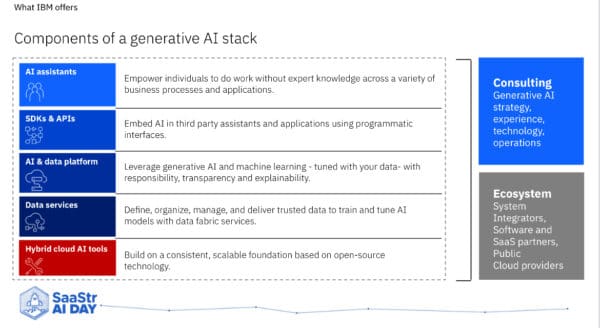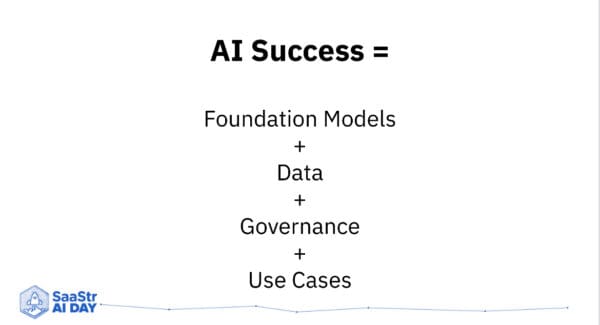At SaaStr’s AI Day, George Kreitler, Global IBM Embeddable AI Sales Leader, talks about the paradox of AI, three equations that relate to the world productivity and AI, a little math to help guide the next decade, top use cases, and the importance of responsible AI.
What Makes Up GDP Growth

From a macro perspective, different variables affect GDP growth in general:
It’s three things.
- Population growth
- Productivity growth
- Debt growth
We know that we won’t see population growth until the medium-to-long term. With debt growth, at least for the foreseeable future, that’s not a real catalyst. That leaves one variable we can leverage — productivity growth.
This is a challenge we’ll face over the next few decades, and it’s different from anything we’ve really faced over the past 100 years. As a society, we’ll be very reliant on productivity growth. Why does this matter in the world of AI?
A lot of folks are skeptical about AI and what it’ll do as far as displacing workers, how decisions that are AI-driven will be made, and how we know the data underlying those decisions. These are all things we, as a collective, will have to attack head-on.
Disruption and responsibility must coexist for us to be successful moving forward.
What Makes Up AI Success Today?

Today, we can build AI models much faster than in the past. At IBM, they fundamentally believe it won’t be one AI model to rule them all. It’ll be a variety of different models fit for a purpose, focused on one specific task that will provide the most value to Enterprises.
You also need data for success. If you and your top competitor use the same foundation model, you’re not using any of your own data there, so you don’t have a competitive advantage.
Data is fundamental to differentiating yourself, and being able to incorporate that into your own AI models will be essential to your own success.
With long-term success comes some approach towards governance, which includes data and AI governance. How does this AI come to the decisions that it did? What is the end-to-end life cycle, and how do you know these AI models are operating in a trusted and transparent way?
Lastly, you need use cases. Not one use case, but as many as possible. That’s where George’s team spends a lot of time, working with partners in various stages of the AI journey and helping them unlock value from AI. That starts with focusing on the right use cases and not just understanding where AI fits but understanding where it may not fit, which is sometimes more important.
The Current GenAI Stack

Putting the models aside, different components make up an overall GenAI stack. Starting with the middle layer, it’s fundamental that there’s some form of AI and data platform. At IBM, they launched Watson X, their approach to an AI and data platform mainly focused on B2B.
This platform lets you do all model training, development, deployment, prompt-tuning, and fine-tuning. That end-to-end model lifecycle needs to be done in a governed and transparent way, so you have a full line of sight to explain the ability of models to come to the decisions they make.
Going Higher Up the Stack
It’s crucial that you’ve got several different software development kits and APIs that help you embed that AI into specific applications, products, and solutions.
One level higher than this, you want to think about fine-tuning and tuning a specific model to address a particular task. These AI assistants are how you interact and solve different tasks leveraging that model, sometimes called assistants or copilots. These copilots are how a majority of the world interacts with AI.
Going a Level Below
A lot of Enterprise is about data services that make AI effective or not. Being able to collect, organize, and manage different data you have across the Enterprise will be fundamental. At IBM, they say there’s no AI without IA, some sort of information architecture.
If you can’t leverage, analyze, and use all data across the Enterprise, you’re doing a disservice to yourself in the long term.
Underpinning all of this is a focus on running AI in a hybrid environment. It’s about running it across public and private Cloud and at the edge. Hybrid and AI will continue to be somewhat synonymous moving forward.
The Top 3 AI Buckets

About 70% of what we see today falls into three categories.
- Digital labor
- Customer experience
- App dev and IT ops
If you think about customer experience today, it’s about how to automate a lot of those front-end interactions with different organizations. How do I focus on high frequency, low complexity tasks that AI is particularly good at and let our agents focus on higher value activities?
Today, agents may be dealing with monotonous tasks daily. It’s tedious and not very fulfilling. AI allows them to focus on higher-value activities.
Across digital labor, there’s an incredible opportunity to apply AI toward talent and HR, finance, supply chain, and procurement. With IBM, they have internally adopted AI across the entire organization, touching all of these categories.
They have AI built into their HR process, handling 94% of requests that are coming in from IBM employees. Digital labor combines AI with automation, not just interacting with a virtual agent but being able to execute and orchestrate different tasks.
The last area is around app development and IT ops or, simply put, code. This involves doing app modernization and code generation and being able to translate, generate, and summarize code.
Today, using IBM’s Watson X platform, about 85% of the time, it provides recommendations to developers around code that the developers accept. It will only get better with time and is an area seeing tremendous growth.
Again, underpinning all of this is AI governance, being able to design responsible AI where you have explainability across the end-to-end lifecycle and the ability to transform your data so you’re leveraging what is your biggest differentiator: your Enterprise data.
Two Use Cases: Ovum and CrushBank

Many folks are getting value from AI today. The first example is Ovum Medical, a company created because they saw a disparity in the care that women were receiving relating to fertility.
For them, it’s all about elevating the level of consistency and objectivity by which they provide care to patients across the world. They offer a telemedicine platform with Watson X built into it and running on the front end.
Watson X can answer questions about healthcare, insurance, fertility, appointments, and more. Why does this use case matter Because it didn’t take months and years to develop and roll out. They got it fully integrated and running on Ovum’s website in a matter of weeks.
CrushBank Technology
CrushBank came from the IT support space where, in the past, they were running strategic outsourcing and providing staff to do IT support for different Enterprises. Along the way, there was a light bulb moment of, “What if we can do this with AI?”
They’ve been able to roll out AI to interact with agents while they’re handling support issues. It’s important when a customer reaches out that they get their questions answered.
CrushBank is seeing support engineers onboarding faster, increasing the number of help desk tickets to close, and decreasing the time to resolution. There are so many ways to use AI to solve different business solutions.
Key Takeaways

1. It’s all about finding the right balance and being a leader in the space where you understand the risks and aren’t scared by them. Companies leaning into AI are growing faster today.
2. It’s also about skills. Skills today are around prompting AI and showing AI how to mimic different actions. Tomorrow, it may be around managing a whole fleet of AI agents to manage various challenges.
3. You need to be open. New models are coming out every week, so stay on top of what’s coming out, how you can leverage it, and how they differentiate from what you’re using today.


